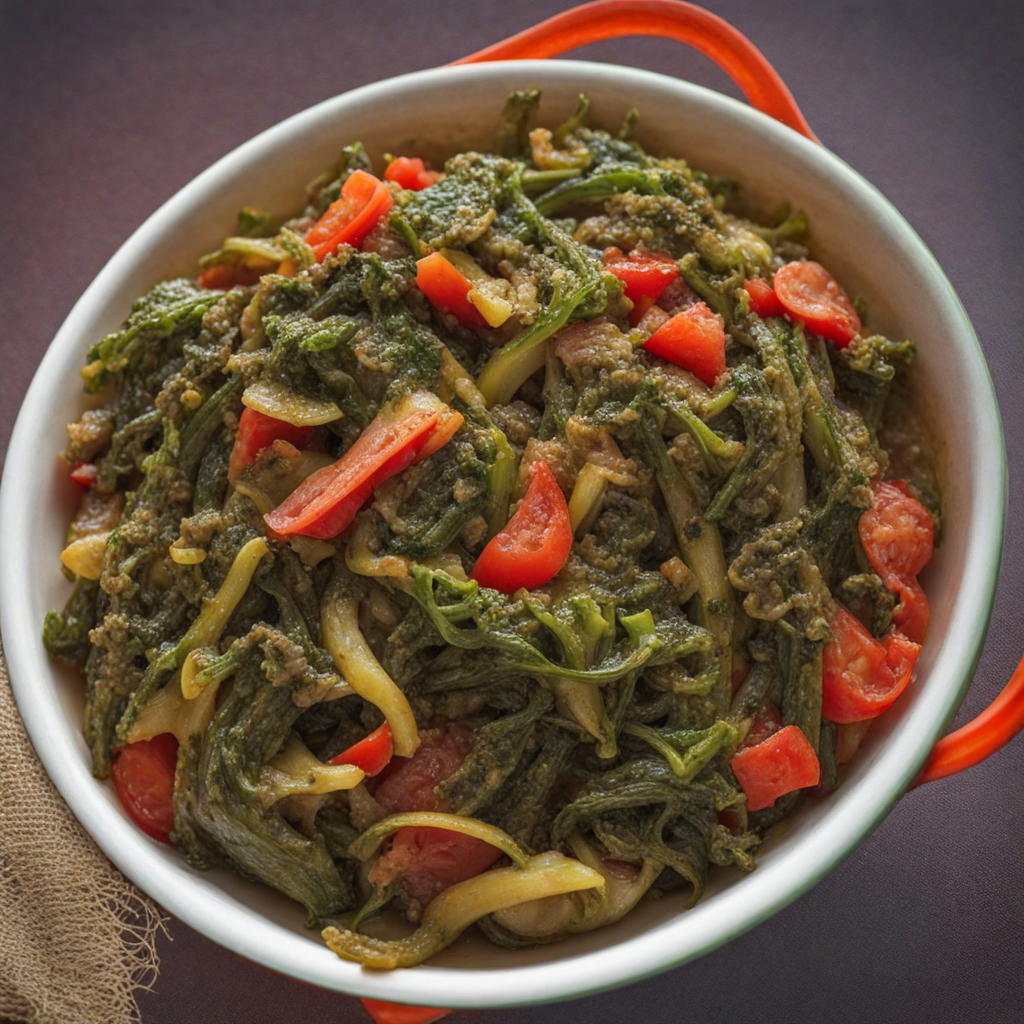Masamba
Masamba is a traditional Malawian dish that showcases the rich flavors and vibrant ingredients of the region. At its core, Masamba refers to a dish made primarily from various leafy greens, which are often sautéed or cooked in a flavorful sauce. The greens, which can include items like pumpkin leaves, cassava leaves, or amaranth, are typically harvested fresh, adding a delightful earthiness to the dish. The preparation involves a mix of onions, tomatoes, and spices, creating a harmonious blend that complements the natural taste of the greens. While the dish is primarily vegetable-based, Masamba can also be enhanced with the addition of proteins such as groundnuts (peanuts) or fish, which are staples in Malawian cuisine. Groundnuts lend a creamy texture and nutty flavor, while fish, often smoked or dried, adds an umami depth to the overall taste. The combination of these ingredients not only provides a satisfying meal but also offers a burst of nutrients, making it a wholesome option for those looking to explore new culinary horizons. Masamba is typically served with a side of nsima, a staple maize porridge that acts as the perfect canvas for the flavorful greens. The two together create a balanced meal that is both filling and nutritious, embodying the essence of Malawian home cooking. The dish is often enjoyed in communal settings, highlighting the importance of sharing meals and fostering connections over food. With its unique flavors and hearty ingredients, Masamba invites food lovers to experience the rich culinary tradition of Malawi.
How It Became This Dish
The History of Masamba: A Culinary Gem of Malawi Masamba, a beloved dish from Malawi, embodies the rich tapestry of the nation's culinary heritage, interwoven with the cultural significance of its ingredients, preparation, and consumption. As a staple food, Masamba primarily refers to a variety of leafy greens, often including mustard greens, amaranth, or pumpkin leaves, prepared in an array of delightful ways. The history of Masamba reflects the evolution of Malawian society, its agricultural practices, and its cultural expressions. #### Origins of Masamba The word "Masamba" derives from the Chewa language, which is one of the principal languages in Malawi. The concept of consuming leafy greens can be traced back to ancient agricultural practices in the region. The Bantu-speaking peoples, who migrated to Malawi from the north around the first millennium AD, brought with them agricultural knowledge and the cultivation of various crops, including maize, sorghum, and various vegetables. The cultivation of leafy greens was an integral part of their diet, providing essential nutrients and vitamins in a predominantly carbohydrate-heavy meal. As the Bantu settled and established communities, they began to integrate local flora into their diets. Masamba, with its reliance on indigenous greens, became a centerpiece of Malawian cuisine. The cultivation of these greens is intimately connected to the land, reflecting the deep reverence for nature that is prevalent in many Malawian cultures. The use of local ingredients speaks to the agricultural practices that have been passed down through generations, emphasizing subsistence farming and the importance of seasonal produce. #### Cultural Significance Masamba is more than just a dish; it is a cultural symbol of Malawian identity. Its preparation and consumption are often communal activities that bring families and communities together. In traditional settings, meals are not merely about nourishment but serve as a means of fostering relationships and strengthening community bonds. Masamba is often served alongside nsima, a thick porridge made from maize flour, which is a staple in Malawian households. Together, they create a balanced meal that reflects the agricultural bounty of the region. The significance of Masamba is further highlighted during communal gatherings and celebrations. In ceremonies such as weddings, festivals, and harvest celebrations, Masamba often features prominently on the menu, showcasing the importance of greens in traditional Malawian cuisine. The dish symbolizes hospitality and abundance, as offering Masamba to guests signifies a warm welcome and generosity. Moreover, Masamba carries spiritual connotations in certain contexts. The cultivation and consumption of leafy greens are sometimes viewed as a connection to ancestors and the land, reinforcing a sense of heritage and identity. The act of gathering greens from the fields can be seen as a ritual, a way of honoring the earth and acknowledging the sustenance it provides. #### Development Over Time As Malawi has evolved through the centuries, so too has the preparation and presentation of Masamba. Historically, the dish was prepared using traditional methods, often involving simple cooking techniques over an open fire. Women would gather the greens from their gardens or local markets, wash them, and prepare them with minimal ingredients, often just salt and water, to preserve the natural flavors. With the advent of globalization and modernization in the late 20th century, the culinary landscape of Malawi began to change. Access to new ingredients and cooking methods introduced variations in the preparation of Masamba. Today, it is not uncommon to find Masamba cooked with a variety of spices, meats, or fish, reflecting the influence of other cuisines and the growing availability of ingredients. This evolution has led to a more diverse interpretation of the dish, appealing to younger generations and urban dwellers who seek to balance tradition with modern tastes. Despite these changes, the core essence of Masamba remains unchanged. It is still rooted in the principles of simplicity and sustainability. The focus on locally sourced, seasonal ingredients preserves the dish's connection to the land and the community. In recent years, there has been a resurgence of interest in traditional foods, as people seek to reconnect with their cultural heritage and understand the nutritional value of indigenous foods. #### Masamba in Contemporary Malawian Society Today, Masamba occupies a significant place in Malawian society. It is commonly found in homes, restaurants, and street food stalls across the country. The dish has also gained recognition beyond Malawi's borders, with Malawian expatriates and food enthusiasts promoting it as part of the African culinary narrative. The rise of the farm-to-table movement has further elevated the status of Masamba. As more people become aware of the environmental and health benefits of consuming locally grown produce, the demand for traditional dishes like Masamba has increased. Farmers are now encouraged to cultivate a variety of leafy greens, which not only supports local economies but also enhances food security. In addition, initiatives aimed at promoting Malawian cuisine globally have contributed to the growing appreciation for Masamba. Food festivals, cooking classes, and cultural exchanges highlight the dish's significance and showcase the culinary diversity of Malawi. By sharing recipes and cooking techniques, chefs and home cooks alike ensure that the legacy of Masamba continues to thrive. #### Conclusion Masamba is a dish that transcends mere sustenance; it is a manifestation of Malawi's rich cultural heritage and agricultural practices. Rooted in the history of the Bantu peoples, it has evolved over time while maintaining its significance as a symbol of community, hospitality, and identity. As the world embraces a more diverse culinary landscape, Masamba stands as a testament to the enduring power of traditional foods to connect people to their heritage, their land, and each other. In a globalized world where the pace of life often overshadows the importance of food traditions, Masamba serves as a reminder of the beauty of simplicity and the profound stories that each meal can tell. Whether enjoyed in a bustling market or around a family table, Masamba continues to nourish not just the body, but also the spirit of Malawi.
You may like
Discover local flavors from Malawi







